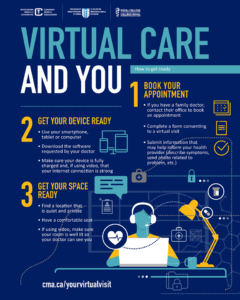
VIRTUAL CARE GUIDE FOR PATIENTS
Canadian Medical Association recomends
VIRTUAL CARE GUIDE FOR PATIENTS

In collaboration with patients and their families, the Canadian Medical Association, the College of Family Physicians of Canada and the Royal College of Physicians and Surgeons of Canada have created this guide to help patients prepare for “virtual visits” with their doctor. It focuses on video visits, although it is also possible to receive virtual care through phone calls, text messaging and email. We recommend that you read the entire guide to gain the best possible results.
BEFORE YOU START
Many patients are enthusiastic about virtual care’s potential but are also understandably concerned about some key issues, such as:
- Is virtual care safe and effective?
- Can I manage the technology to connect with my doctor?
- Will the system be secure enough to ensure my privacy?
- How will virtual care affect my relationship with my doctor?
Fortunately, the answer to the first three questions is usually yes. And both patients and doctors who have experience with virtual care report that it has a positive effect on their relationship.
With those reassurances, let’s look at what you need to know to take advantage of virtual care, and particularly video visits.
WHO PAYS FOR VIRTUAL CARE?
THERE ARE THREE WAYS TO COMPENSATE DOCTORS FOR PROVIDING VIRTUAL CARE:
Publicly funded medical coverage: In most provinces and territories, virtual care is not covered by government health insurance programs. But there are exceptions, particularly during infectious outbreaks, and there is growing interest in broadening public insurance coverage for virtual visits.
Employer-paid insurance: Many employers now offer free virtual health care to employees and their dependents.
Patient paying out of pocket: For patients who are willing to pay for virtual care, there are private companies who sell individual visits or subscriptions for virtual care with physicians.
Check to see whether your provincial/territorial government covers it (contact your doctor or your provincial/territorial medical insurance plan) or whether your employer covers it.
WHAT IS AND ISN’T SUITABLE FOR VIRTUAL CARE
While many medical problems can be assessed and treated via virtual care, there are others that cannot be safely managed without an in-person physical examination.
YOU CAN SAFELY USE VIRTUAL VISITS FOR:
- mental health issues;
- many skin problems (photos that you take in advance provide better images than video);
- urinary, sinus and minor skin infections;
- sore throats, if your doctor can arrange a throat swab to test for strep;
- eye redness without pain or change in vision;
- sexual health, including screening and treatment of sexually transmitted infections, and hormonal contraception;
- travel-related health care;
- conditions monitored with home devices and/or lab tests (e.g., blood pressure, cholesterol, thyroid and some parts of diabetes care); and
- review of lab tests, imaging (e.g., x-rays and ultrasounds) and specialist reports.
Some problems are not appropriate for virtual care because a doctor would need to physically examine you. This includes:
- new emergency symptoms such as chest pain, shortness of breath, loss of vision, loss of hearing, sudden weakness or numbness (you’d need to go to a hospital emergency department);
- ear pain (your doctor would need to look inside your ear, which can’t be done via video);
- cough (your doctor would need to listen to your chest with a stethoscope);
- abdominal or digestive problems (your doctor would need to feel your belly); and
- muscle and joint injuries (your doctor would need to feel the affected area for tenderness, warmth, etc.).
Although you may need to see a doctor in person for your first appointment for these types of problems, follow-up visits may be well suited to virtual care.
As time passes, we expect new innovations and research will increase the range of problems that doctors can assess safely via virtual visits.
ARRANGING A VISIT
If you have a regular family doctor, that doctor’s office should be your first point of contact for any problem that is appropriate for a virtual visit. If you are looking for specialist care via a virtual visit, you should likewise start with your existing doctor, who is familiar with you and your condition.
REGARDLESS OF WHERE YOU OBTAIN A VIRTUAL VIDEO OR PHONE VISIT, YOU NEED TO MAKE SOME ARRANGEMENTS IN ADVANCE:
PREPARING YOUR
COMMUNICATIONS DEVICE
AND CONNECTION FOR A VIDEO VISIT
There are several steps to take to be ready for a video visit:
Choose whether you will use Download the app or install
a smartphone, tablet or the software that your doctor’s computer. office uses for video visits.
| If you can’t connect by video, ask your doctor if you can connect by phone instead. |
Make sure that the device is When possible, use earphones/ fully charged or plugged in. headphones because they
provide a better microphone and sound, as well as greater privacy.
Video requires a high-speed and stable Internet connection. If possible, arrange a test call To get the best possible with the doctor’s office or with Internet performance: a family member or friend.
- Use a wired rather than wireless connection whenever possible.
- If you have to use a wireless
connection, be prepared to switch
from your WiFi to your cellphone data plan. Although it can be costly
to use your cellphone data plan,
your phone will often give you a
faster Internet connection.
CHOOSING AN APPROPRIATE
LOCATION FOR A VIDEO VISIT
Choose a location for the video visit that is private, free of distraction and comfortable. Specifically:
- have a comfortable seat with adequate lighting so that the doctor can see you;
- try to be somewhere where other people can’t see or hear you (this can be a challenge at home); and
- eliminate as much surrounding noise as possible.
THINGS TO HAVE WITH YOU AT THE START OF THE VISIT
Video visits are like in-person appointments when it comes to what you should have in hand:
- your health insurance card (if your province/territory’s health cards don’t include a photo, also be sure to have photo ID so that the doctor can confirm your identity);
- a list of your symptoms, when each started and how severe they are;
- any recorded data such as weight, temperature, home blood pressure and pulse readings;
- information about any contacts with similar symptoms;
- if you haven’t seen this particular doctor before, your relevant health history:
- chronic conditions o prescription medications (have your pill containers at hand with the pharmacy label) o allergies o immunizations
- past surgeries and hospitalizations
- your immediate family’s health history (parents and siblings); and
- any questions that you have for the doctor.
If you want to include a family member or other person who supports you in managing your health care, arrange for them to be with you.
Note for video visits for children: your child must be on camera for at least part of the visit.
DURING THE VIDEO VISIT
There are both familiar and new things during video visits. The new things relate to proving your identity to the doctor (“verification”) and managing remote communication:
- Be aware that you may have to wait “on the line” before the doctor joins the video visit.
- Expect that the doctor will ask you for your photo ID and geographic location.
- The doctor must identify themself and tell you where they are located and where they hold a medical license. Ask for that information if they don’t volunteer it.
- Remain in front of the camera and speak clearly so that the doctor can see and hear you.
- Let the doctor know if someone else is with you and introduce them.
- If there is background noise where you are located, mute your microphone when you are not speaking.
- Present your symptoms and answer questions as clearly and directly as possible.
- Make notes about the doctor’s opinion and recommendations and ask questions if anything isn’t clear.
| Virtual care is one of the great medical innovations of our time. If you feel that your health care can benefit by replacing in-person visits with video visits, phone calls or messaging, speak with your doctor about introducing this kind of visit into your patient–doctor relationship. |
After the visit ends, you may receive a written summary from the doctor via secure messaging (e.g., a “portal”, like online banking, or through the video software chat feature). Review it and communicate with the doctor if there is anything that appears unclear or incorrect.
This Virtual Care Guide for Patients was co-created with members of the CMA Patient Voice, a group of patient representatives that advise the CMA on key health issues from a patient’s perspective.









-
Tagged australia, bianca, dani madeline, Demi Lovato, justin Bieber